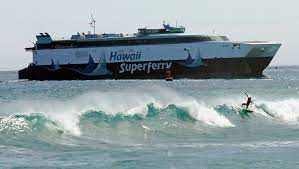Nestled in the Pacific Ocean, the Hawaiian archipelago has long been a symbol of natural beauty and cultural richness. The islands, each with its unique allure, are connected not just by the waters that surround them but also by the rich history of maritime travel. This article delves into the ambitious Hawaii Superferry project – a venture that promised to revolutionize interisland transportation but faced an untimely demise, and explores the evolving landscape of transportation in Hawaii.
The Inception and Vision of Hawaii Superferry:
- Background and Objectives: The concept of the Hawaii Superferry was born from a vision to enhance interisland connectivity, reduce travel times, and offer an alternative to air travel. Funded by both private and public investments, the project was seen as a catalyst for economic growth, potentially boosting interisland trade and tourism. This vision included creating a service that was not just a mode of transportation but an experience in itself, with the promise of scenic voyages and comfortable amenities.
- Design and Capabilities: The Superferry was a marvel of modern maritime engineering. The vessels, Alakai and Huakai, were designed to carry over 800 passengers and 200 vehicles each. They boasted amenities like spacious lounges, on-board dining options, and large windows for panoramic ocean views. The ferries were built with the capability to travel at high speeds, reducing travel time significantly compared to conventional ferries.
Hawaii Superferry: A Revolutionary Transportation Mode:
- Operational Highlights: The Superferry began its operations with much fanfare, offering routes primarily between Oahu and Maui. The journey was advertised as not just a means to an end but a part of the vacation experience itself. Passengers recounted the joy of watching the Hawaiian coastline unfold from the deck, a view that was previously limited to air travel.
- Comparative Analysis: Compared to traditional ferry services and flights, the Superferry was a game-changer. It provided a viable alternative for transporting large vehicles and goods, which was a significant advantage for businesses. Moreover, the journey time, although longer than a flight, was offset by the comfort and unique experience it offered.
Legal and Environmental Hurdles:
- The Legal Battles: The Superferry’s journey was soon overshadowed by legal challenges. Environmental groups raised concerns about the potential impact on marine ecosystems, particularly on endangered species like humpback whales. The legal battles peaked with a Hawaii Supreme Court ruling that demanded a comprehensive Environmental Impact Report (EIR), a requirement the project had initially bypassed.
- Environmental Concerns: The environmental concerns were not unfounded. Hawaii’s marine ecosystems are delicate, and the introduction of a large, high-speed ferry raised questions about potential disturbances to wildlife, coral reefs, and coastal erosion. These concerns galvanized a section of the community and led to protests and public campaigns against the Superferry.
Economic Impact and Public Reception:
- Economic Analysis: Economically, the Superferry’s impact was multifaceted. On one hand, it promised economic benefits through tourism and trade. However, its operational halt led to significant financial losses and job layoffs. The project, which had seen investment from both the government and private sectors, became a point of contention in discussions about public spending and economic planning.
- Community Perspectives: The public reception of the Superferry was mixed. While many commuters and businesses appreciated the convenience and service it offered, others were concerned about its environmental and cultural impacts. This section would delve into various community perspectives, including interviews with local residents, business owners, and cultural leaders, offering a comprehensive view of the Superferry’s societal impact.
The Last Voyage: An End of an Era:
- Narratives from the Final Journey: The Superferry’s last voyage was an emotional moment for many. Crew members spoke of their pride in being part of a revolutionary service, while passengers shared stories of the unique experiences they had on board. This section would recount personal narratives and reflections, painting a vivid picture of the Superferry’s final days.
Aftermath and Auction: The Fate of the Superferries:
- Post-Shutdown Developments: Following the shutdown, the Superferry vessels were auctioned off, marking the end of what was once a symbol of progress and innovation. This section would provide a detailed report on the auction process, the fate of the vessels, and the financial aftermath for the investors and the state.
- Lessons Learned: The Superferry saga offers valuable lessons in project management, environmental stewardship, and community engagement. This section would analyze these lessons, discussing how they can inform future transportation projects in Hawaii and beyond.
Alternatives to the Superferry: Current State of Interisland Travel:
- Current Transportation Landscape: With the Superferry no longer in operation, interisland travel in Hawaii has primarily reverted to air travel and private boat charters. This section would explore the current transportation landscape, examining the pros and cons of these alternatives in terms of sustainability, accessibility, and economic impact.
- Comparative Analysis: This section would provide a detailed comparison of the current transportation methods, considering factors like environmental impact, cost-effectiveness, and traveler experience. It would also explore how these methods meet the needs of different traveler segments, from tourists to local residents.
Looking to the Future: Sustainable Interisland Transportation:
- Innovative Solutions: Looking ahead, this section explores potential solutions for sustainable interisland transportation. Ideas like electric ferries, improved air travel options, and innovative logistics solutions are discussed, along with their feasibility and potential impacts.
- Expert Opinions: Featuring insights from transportation experts, environmental scientists, and policymakers, this section delves into expert perspectives on what the future of interisland travel in Hawaii could look like. It discusses the balance between technological advancements, environmental responsibility, and cultural considerations.
Conclusion: The Hawaii Superferry’s journey, from a bold vision to an abrupt end, serves as a poignant reminder of the complexities inherent in balancing development with environmental and cultural stewardship. As Hawaii continues to evolve, the lessons from the Superferry experience will undoubtedly shape the future of interisland transportation.
